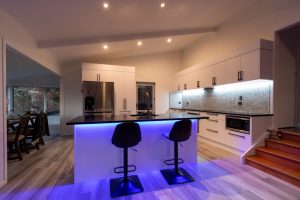
Shine Bright Like a Modern Chandelier: Elevating Your Home Decor with Contemporary Lighting
Lighting plays a crucial role in home decor. It not only provides illumination but also sets the mood and ambiance of a room. The right lighting can enhance the overall design of a space and create a welcoming and comfortable atmosphere. From chandeliers to LED lights, there are various options available to suit different styles and preferences. In this article, we will explore the importance of lighting in home decor, the evolution of chandeliers, contemporary lighting trends, choosing the right chandelier for your space, incorporating modern chandeliers into your home decor, the benefits of LED lighting, enhancing your home’s ambiance with lighting control systems, creative ways to use lighting to highlight your home’s features, maintenance and cleaning tips for modern chandeliers, and the benefits of investing in quality lighting fixtures.
The Importance of Lighting in Home Decor
Lighting has a significant impact on the mood and ambiance of a room. It can make a space feel warm and inviting or cold and sterile. Different types of lighting serve different purposes in home decor. Ambient lighting provides overall illumination and sets the general mood of a room. Task lighting is focused on specific areas where activities such as reading or cooking take place. Accent lighting is used to highlight architectural features or artwork. By using a combination of these types of lighting, you can create a layered effect that adds depth and dimension to your space.
In addition to its functional aspects, lighting also enhances the overall design of a space. It can be used as a decorative element to complement the style and theme of a room. For example, a traditional chandelier can add elegance and sophistication to a formal dining room, while a modern pendant light can bring a contemporary touch to a minimalist living room. The right lighting fixtures can become focal points in a room and tie together all the design elements.
The Evolution of Chandeliers: From Traditional to Modern
Chandeliers have come a long way since their inception. Originally used to hold candles, they have evolved into stunning light fixtures that can transform any space. Chandeliers have gone through various design changes over the years, reflecting the trends and styles of different eras. From traditional crystal chandeliers to modern and minimalist designs, there is a wide range of options available to suit different tastes.
Traditional chandeliers are characterized by their ornate designs and use of materials such as crystal, brass, and bronze. These chandeliers often feature intricate details and elaborate shapes. Transitional chandeliers combine elements of both traditional and modern styles, creating a timeless and versatile look. They often feature clean lines and simpler designs, while still incorporating some decorative elements. Modern chandeliers, on the other hand, embrace minimalism and simplicity. They often feature sleek lines, geometric shapes, and use materials such as glass, metal, and wood.
Contemporary Lighting Trends for Your Home
In recent years, there have been several lighting trends that have gained popularity in home decor. One of these trends is the use of minimalist designs. Minimalist lighting fixtures are characterized by their clean lines, simple shapes, and neutral colors. They blend seamlessly into any space and create a sense of calm and tranquility.
Another popular trend is the use of mixed metals. Instead of sticking to one type of metal finish, homeowners are now mixing different metals to create a more eclectic look. For example, a dining room may feature a chandelier with a combination of brass and black finishes, while the kitchen may have pendant lights with copper and silver finishes. This trend adds visual interest and depth to a space.
Geometric shapes are also making a comeback in lighting design. From hexagonal pendant lights to triangular wall sconces, geometric shapes add a modern and contemporary touch to any room. These fixtures create a focal point and become a statement piece in the space.
Choosing the Right Chandelier for Your Space
When choosing a chandelier for your space, there are several factors to consider. The size of the chandelier is one of the most important considerations. It should be proportionate to the size of the room and the height of the ceiling. A small chandelier in a large room may get lost, while a large chandelier in a small room may overwhelm the space. It is also important to consider the style of the chandelier and how it will fit in with the overall design of the room.
The height at which the chandelier is hung is another important factor to consider. In dining rooms, the bottom of the chandelier should be approximately 30 to 36 inches above the table. In entryways or foyers, the chandelier should be hung at a height that allows for clearance when walking underneath it.
The placement of the chandelier is also crucial. It should be centered in the room and positioned in a way that allows for even distribution of light. In rooms with high ceilings, it may be necessary to use a chain or rod to lower the chandelier to an appropriate height.
How to Incorporate Modern Chandeliers into Your Home Decor

Modern chandeliers can be incorporated into different design styles to create a cohesive and visually appealing look. In industrial-style spaces, a modern chandelier with exposed bulbs and metal finishes can add a touch of sophistication and elegance. In bohemian-style spaces, a modern chandelier with organic shapes and natural materials such as wood or rattan can create a boho-chic vibe. In mid-century modern spaces, a modern chandelier with clean lines and retro-inspired designs can enhance the overall aesthetic.
To create a cohesive look, it is important to mix and match different lighting fixtures throughout your home. For example, you can use a modern chandelier in the dining room, pendant lights in the kitchen, and wall sconces in the living room. By using different types of lighting fixtures, you can create a layered effect that adds depth and dimension to your space.
The Benefits of LED Lighting for Your Home
LED lighting has become increasingly popular in recent years due to its numerous benefits. One of the main advantages of LED lighting is its energy efficiency. LED bulbs use significantly less energy than traditional incandescent bulbs, resulting in lower electricity bills and reduced carbon footprint. LED bulbs also have a longer lifespan, lasting up to 25 times longer than incandescent bulbs. This means less frequent bulb replacements and less waste.
LED lighting is also highly versatile. It can be used in various areas of the home, including task lighting in the kitchen, ambient lighting in the living room, and accent lighting in the bedroom. LED bulbs are available in different color temperatures, allowing you to create different moods and ambiance in each room.
Enhancing Your Home’s Ambiance with Lighting Control Systems
Lighting control systems offer a convenient and customizable way to enhance your home’s ambiance. These systems allow you to control the brightness, color, and timing of your lights with just a touch of a button or a voice command. With lighting control systems, you can create different scenes for different activities or moods. For example, you can have a “movie night” scene that dims the lights and sets a cozy ambiance, or a “party” scene that brightens the lights and adds color.
There are different types of lighting control systems available, ranging from simple dimmer switches to more advanced smart home systems. Dimmer switches allow you to adjust the brightness of your lights manually. Smart home systems, on the other hand, offer more advanced features such as voice control, remote access, and integration with other smart devices in your home.
Creative Ways to Use Lighting to Highlight Your Home’s Features
Lighting can be used creatively to highlight architectural features, artwork, and other design elements in your home. For example, you can use recessed lighting to highlight a beautiful ceiling or a decorative wall. You can also use track lighting or picture lights to illuminate artwork or photographs. By using lighting strategically, you can draw attention to specific areas and create a focal point in the room.
Layering lighting is also important for creating a dynamic and visually appealing space. Instead of relying on one source of light, it is recommended to use a combination of ambient, task, and accent lighting. This creates depth and dimension in the room and allows for flexibility in adjusting the mood and ambiance.
Maintenance and Cleaning Tips for Modern Chandeliers
To keep your modern chandelier looking its best, regular maintenance and cleaning are essential. Dust and dirt can accumulate on the surface of the chandelier, dulling its shine and reducing its effectiveness. To clean your chandelier, start by turning off the power to the fixture. Use a microfiber cloth or a soft brush to gently remove any dust or dirt from the surface. Avoid using harsh chemicals or abrasive materials, as they can damage the finish of the chandelier.
If your chandelier has glass or crystal components, you can use a mixture of mild dish soap and warm water to clean them. Dip a soft cloth or sponge into the soapy water and gently wipe the glass or crystal components. Rinse with clean water and dry with a soft cloth to prevent water spots.
Regular maintenance is also important for the longevity of your lighting fixtures. Check for loose screws or other signs of wear and tear regularly, and tighten or replace any parts as needed. By taking care of your modern chandelier, you can ensure that it remains in excellent condition for years to come.
Investing in Quality Lighting: Why it’s Worth It for Your Home
Investing in quality lighting fixtures is worth it for several reasons. First and foremost, quality lighting fixtures are more durable and long-lasting compared to cheaper alternatives. They are made with high-quality materials and craftsmanship, ensuring that they can withstand daily use and last for many years. This means fewer replacements and less waste.
Quality lighting fixtures also offer better design and aesthetics. They are often designed by renowned designers and feature unique and innovative designs. They can become focal points in a room and add a touch of elegance and sophistication to your space.
In addition, quality lighting fixtures are more energy-efficient, resulting in long-term cost savings. They often use LED bulbs, which consume less energy and have a longer lifespan compared to traditional incandescent bulbs. This means lower electricity bills and reduced carbon footprint.
Lighting is an essential element in home decor that can greatly impact the mood, ambiance, and overall design of a space. From chandeliers to LED lights, there are various options available to suit different styles and preferences. By choosing the right lighting fixtures and incorporating them strategically into your home decor, you can create a welcoming and comfortable atmosphere that reflects your personal style. Investing in quality lighting fixtures is worth it for the durability, design, and long-term cost savings they offer. So why not brighten up your home with the perfect lighting?

